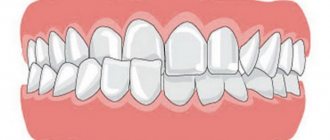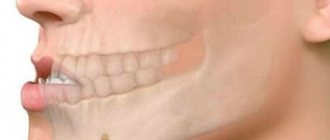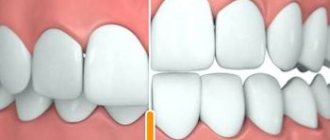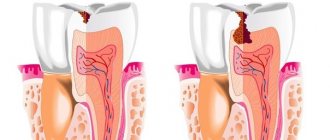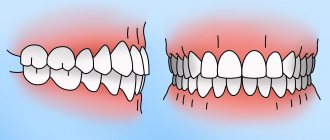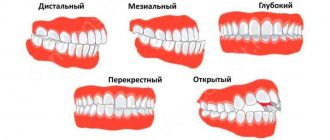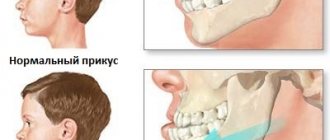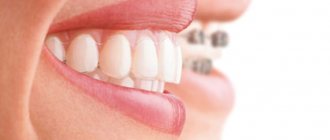There are cases when it is not possible to correct a malocclusion using braces and aligners, when it is not the pathological location of the teeth, but skeletal disorders in the jaws. Such as mesial or distal bite, when the lower jaw is located in front of the upper jaw or vice versa. In such situations, it is impossible to correct the bite using a conservative method. We resort to radical surgery to correct the bite - we correct the bite surgically, thereby lengthening or shortening the jaws and chin. Such operations can improve the profile of the face, make it more symmetrical and, as a fact, more attractive.
It should be clarified that operations to correct the bite are carried out during the period of completion of the formation of the jaws. Until the age of 18, the need for surgical intervention is decided strictly on an individual basis. Such operations are carried out if there are very serious deviations that are not amenable to other types of treatment.
In old age, these surgical interventions are recommended to be performed up to 60 years of age. If the patient is older, then the need for surgical intervention is decided individually, taking into account concomitant diseases.
In Krasnodar, surgical interventions to correct bites are carried out in many specialized clinics and hospitals.
How is a bite corrected surgically?
What is surgical orthodontics and when is it performed?
Radical surgical orthodontics is used to correct the bite when a change in the position of the teeth will lead to a deterioration in the patient’s condition, increased muscle tone, and, as a consequence, neurological disorders. With a mesial position of the lower jaw, or with its distal position, with pathological asymmetry of the face, when as a result of this the quality of life changes.
When a patient has a diction disorder that qualitatively disrupts his social life and alternative treatment does not lead to results, radical surgery is resorted to.
This manipulation is not performed in our clinic for a number of blood pathologies, for hormonal diseases, for immunodeficiencies, for children under 18 years of age, for diseases of a psychological nature.
The procedure itself is a surgical intervention into bone tissue. This manipulation is called osteotomy. The surgeon augments the bone or reduces its volume, makes an incision in the jaw, and can change the shape of the chin.
Correction of the midface (moving the upper jaw forward), chin reduction
| As we have already understood, the cause of deformation of the midface in this case is the too “backward” position of the upper jaw (retroposition). Accordingly, to solve the problem, you need to move the jaw anteriorly , which was done. Through incisions inside the mouth, the upper jaw was cut and moved by 6 mm. anteriorly and fixed in the new position with titanium plates. In addition, the chin was reduced. What happened: | ||
| As a result of the operation, the middle area of the face was “straightened” and “filled out” . This is especially noticeable in the side shot. Also pay attention to how the position of the lips has changed - they have received the correct support . The chin became smaller and also changed shape. But one more problem still remained unresolved. |
Indications for surgery
Today, patients themselves can insist on orthodontic surgery, or the doctor insists on this type of surgical intervention.
Indications for radical surgery to correct the bite are:
- significant underdevelopment of the lower jaw, or an upper jaw that is too forward
- if the teeth do not close in the lateral or anterior sections, the so-called open bite, which interferes with normal chewing of food
- if there are abnormalities in the development of the chin
- when the patient has significant diction problems
- if the patient received injuries that led to jaw deformities.
Contraindications to surgery
Correction of the bite in a dental clinic by surgical intervention is not performed in children and adolescents, as well as in older people. The operation involves risks, so there are restrictions on its implementation.
Surgical bite correction is contraindicated in patients who have:
- pathologies of the cardiovascular system;
- blood diseases, including poor clotting;
- diseases of the skeletal system;
- dysfunction of the endocrine system;
- severe form of diabetes mellitus;
- mental illness;
- immunodeficiency diseases;
- acute inflammatory, infectious or viral diseases.
Surgical treatment of malocclusions is not performed for aesthetic purposes. The main task of the maxillofacial surgeon is to restore all functions for which the dentofacial apparatus is responsible, as well as eliminate concomitant pathologies.
Preparation
Preparation for the operation to correct the bite is carefully carried out by our doctors; all plaque and tartar are removed; for this, a qualified hygienist will perform a series of manipulations to remove supragingival and subgingival deposits.
A general practitioner and a surgeon will treat caries and its complications, and remove teeth that have been destroyed at the root. In our clinic you can undergo all the necessary examinations before surgery and have a computed tomogram done on the latest tomograph. The dentist-surgeon together with the orthodontist will plan the future result and make a template.
Maxillofacial Surgery
About the new maxillofacial clinic Dental-Service
“Clinic of Facial Surgery and Dentistry” opened in November 2021 on the territory of the largest conglomerate of advanced medical institutions in Novosibirsk - Medpark, st.
Sacco and Vanzetti, 77. The main activity of the new clinic is maxillofacial surgery. The list of services includes: orthognathic operations to correct the bite, operations on the sinuses and salivary glands, the temporomandibular joint, restoration of the maxillofacial area after injuries. A powerful advantage to oral and maxillofacial surgery are the traditional dental areas of the network: therapeutic dentistry, surgery, periodontology, orthodontics. More details
The format of the new clinic is initially designed for a comprehensive solution to the patient’s problems, which means it implies teamwork: maxillofacial surgeons, orthodontists, orthopedists, implant surgeons, dental therapists, ENT surgeons, and neurosurgeons work together. This interdisciplinary approach is very convenient, since the patient receives the most qualified solution within the walls of one clinic. The conditions of the clinic - tomography, microscopes, three class A and B operating rooms, full-scale anesthesia, post-anesthesia wards, a comfortable hospital - allow both maxillofacial and dental surgeries to be performed at the most modern level. Large-scale bone reconstructions (including using bone from extraoral sources - this is a rare, complex operation), implantations, apical surgical operations, extensive periodontal reconstructions and aesthetic dentistry - all these areas are represented “to the maximum” in the new clinic. The team of the new clinic consists of surgeons with many years of experience in maxillofacial surgery, trained in clinics in Europe, China, and the USA, and experienced dentists from the Dental-Service network. The chief physician is surgeon Oleg Valentinovich Pakhomov.
image/svg+xml PAKHOMOV Oleg Valentinovich Chief physician of the clinic We have combined dentistry and maxillofacial surgery. This is a completely new format for our region. Dental-Service, as always, is the first to meet new challenges of modern dentistry. Within the walls of one clinic, we will correct congenital pathology of the jaws and, if necessary, carry out bone and periodontal reconstruction, implantation, and autotransplantation. An interdisciplinary approach is the only correct path of modern medicine.
Malocclusions: when orthodontists fail
Braces for adults
Find out more about our orthodontics.
The bite is called malocclusion if the upper and lower jaws do not correspond to each other, the dentition does not close properly and, as a result, the food is not ground sufficiently. A smile with an overbite does not necessarily look bad. Bite is more related to health and often makes itself felt after 30 years, when pain in the temporomandibular joints may appear, the roots of the teeth are exposed, breathing is impaired, increased wear of the teeth is a concern, etc. The aesthetic task (to make a beautiful smile) and the functional task (to make the bite correct) are always solved together.
Usually, orthodontists are involved in correcting the bite. But in approximately 25% of patients diagnosed with “malocclusion,” the discrepancy between the sizes of the upper and lower jaws is so great that it is impossible to compensate for it and achieve a correct bite using the standard orthodontic method (braces).
Such a skeletal anomaly causes disturbances in chewing, speech, posture, and psychological disorders. And, as a rule, it seriously affects a person’s appearance and distorts his natural beauty.
image/svg+xml Correct bite is determined by the relative position of the teeth on the upper and lower jaw
What do orthodontists usually do in cases of severe jaw discrepancy? Treatment is carried out using braces, somewhat compensating for the skeletal anomaly, temporarily postponing the adverse consequences of malocclusion. It is extremely rare that they recommend jaw surgery to a patient. This is largely due to the imperfection of the organization and conduct of such operations. There is simply nowhere to send such a patient for surgical treatment in our region! The emergence of the “Clinic of Maxillofacial Surgery Dental-Service”, we are sure, will radically change this situation in the Siberian Federal District.
The world practice in such cases is teamwork of an orthodontist and a maxillofacial surgeon. At the first stage, orthodontic correction is performed, at the second stage, orthognathic surgery is performed by a maxillofacial surgeon. The third stage is the final polishing of the result using orthodontic methods. The result of such cooperation between specialists is a beautiful, even face and correct bite.
We always meet you halfway: we treat you in installments
Apply for an interest-free installment plan from the clinic administrator.
We perform orthognathic surgery in D-S
Orthognathic surgery is close to plastic surgery, as it not only corrects skeletal abnormalities (makes the bite correct), but also restores the natural balance of the face. Orthognathic surgery is a general name for a whole class of surgeries. The highly specialized names of which - osteotomy, genioplasty - will not tell a layman anything. But they all imply a change in the shape of the bone tissue of the upper and lower jaws - reduction, extension, movement. Although such operations cannot be called simple (they require serious preparation and technological support), the protocol for such operations has been worked out. The number of orthognathic operations performed annually in countries with a developed dental culture amounts to thousands.
Orthognathic surgery in the new Dental-Service maxillofacial clinic is a one-day operation. Minimally invasive intervention is provided with high-tech equipment: modern methods of anesthesiology, the use of the latest equipment, as well as the highest qualifications of the surgeon. An obligatory stage of any orthognathic operation is orthodontic correction using braces. The orthodontist works closely with the surgeon, prepares the patient’s jaw for surgery and carries out postoperative correction.
Osteotomy (orthognathic surgery) of one jaw
If one of the jaws is underdeveloped or, conversely, overdeveloped, the bite and balance of the face are disrupted. This anomaly can only be corrected surgically. Osteotomy is necessarily accompanied by orthodontic correction: orthodontic treatment is carried out in the pre- and postoperative period.
image/svg+xml Osteotomy of one jaw The bone tissue of the jaw is cut behind the molars, due to which the jaw can be moved and set in the desired position. Then titanium plates are fixed.
Double jaw osteotomy
An operation to correct severe malocclusion pathology and aesthetic facial anomalies, which is performed simultaneously on both jaws. Osteotomy is also carried out jointly with an orthodontist: orthodontic treatment is carried out in the pre- and postoperative period.
image/svg+xml Double-jaw osteotomy The bone tissue of the lower and upper jaws is dissected, placed in the desired position and fixed with titanium plates.
Genioplasty
The operation is performed to change the contours of the chin and is performed primarily for aesthetic purposes. It can be performed as an independent operation, or it can complement osteotomy of the lower jaw.
image/svg+xml Genioplasty: dissection, movement, fixation of the bone tissue of the chin.
Simulation of maxillofacial surgery
One of the main advantages of the new Dental Service maxillofacial clinic is accurate planning of future surgery. A modern technique based on 3D computer modeling allows you to calculate the progress of the operation and see the final result even before the start of any treatment, before the start of primary orthodontic correction.
image/svg+xml GORYACHKIN Alexander Mikhailovich Leading maxillofacial surgeon Proper preparation is the most important stage, half the success. Thanks to computer simulation and the use of operating templates, we perform operations very accurately. Without a template, high-quality orthognathic surgery is basically impossible! Learn more about the planning program from the video
CHL: what else are we doing?
Check-up “Face Balance”
The harmonious development of bone structures and soft tissues of the face and jaw are fundamentally important for facial beauty. This is the frame on which its proportions depend. For patients who want to check how fully the potential of their natural beauty is realized, the Clinic of Facial Surgery and Dentistry offers.
History of success
The story is told by Vika, who knows firsthand what the maxillofacial surgery is. The
Check-up operation “Balance of the face and smile” is a comprehensive medical examination and computer analysis of the bone structures and soft tissues of the face, revealing functional and aesthetic deviations in the structure of the maxillofacial area. facial area. Diagnosis is carried out using the latest functional research methods, taking into account the anatomical and physiological characteristics of the organs and tissues of the oral cavity and maxillofacial area, as well as the specifics of dental diseases. An integral stage of the study is an analysis of the shape and position of the teeth and gums. The technique also helps to diagnose some diseases that occur unnoticed. If asymmetry in the maxillofacial area is detected, the program will simulate how the face would look if the imbalance was corrected. We identify all types of asymmetries that affect facial balance:
- gum asymmetry,
- teeth,
- jaws,
- soft tissues,
- joint asymmetries.
Diagnostics takes 1-2 hours, the results of the study are ready in 7 days. Further treatment, if necessary, can be done at any clinic. Our specialists will conduct an expert consultation with the doctor you choose for further treatment.
Surgical expansion of the hard palate
The operation is performed to widen the narrow upper jaw to correct malocclusion. After the operation, a distraction device is used, which further expands the upper jaw. Once the distraction device is removed, the teeth are finally straightened using braces or orthodontic trays.
Facial injuries
We work with the consequences of injuries to bones and soft tissues in the maxillofacial area, including old ones.
Progress of the operation
Surgical correction of the bite is carried out in our clinic under general anesthesia under the guidance of an experienced chief physician and anesthesiologist-resuscitator and orthodontist. The duration can take from 15 minutes to 4 hours in complex cases. The operation itself includes the surgical stage itself, when access to the bone is carried out surgically through soft tissue in order to correct its position. The surgeon performs manipulations to reduce or increase the volume of bone tissue, or to displace it using a special surgical set and elements for fixing the bone (various splints, screws).
If the patient’s condition allows and there is a need, braces are installed immediately after surgery. After surgery, a fixing bandage is applied to the face. Sutures are placed on soft tissues, and the wound surface is treated.
In complex clinical cases, due to the proximity of other organs to the operated area, we involve the appropriate specialists - ophthalmologists, plastic surgeons, otorhinolaryngologists.
Since the operation is performed exclusively under general anesthesia, it is painless for the patient, under constant monitoring of the condition of vital organs and systems by an anesthesiologist.
Treatment of distal occlusion in adults
It is impossible to correct prognathia in an adult using orthodontic methods alone. They use a whole range of different dental methods:
- Orthognathic surgery. The size of the jaws is surgically adjusted.
- Orthodontic alignment of teeth. For this purpose, braces systems are used.
- Myo-gymnastics, developing facial and chewing muscles.
- Genioplasty to correct a receding chin due to an underdeveloped lower jaw.
Chin plastic surgery allows you to avoid complex surgery to build up the lower jaw to a physiological norm. Correction occurs through the installation of silicone implants.
Recovery period
The recovery stage after surgery is the longest. Since maxillofacial surgery, which is performed to restore malocclusions and straighten teeth, with distal occlusion in adults, the jaw often has to be broken, which is a complex surgery, and the recovery process in such patients takes longer and is quite painful.
In the postoperative period, there may be an increase in temperature, pain, and swelling of the face. It is important to strictly follow the recommendations that the surgeon gives after the operation.
The doctor will prescribe you a number of medications, give you all recommendations on nutrition, hygiene, and prescribe follow-up examinations and suture removal.
The healing period depends on the extent of the intervention and, as a rule, lasts from several weeks to 2 months.
Our specialists are in touch with patients around the clock, which allows us to reduce postoperative complications to zero.
Rehabilitation
After surgical correction of the bite, the patient should be prepared for long and complex rehabilitation. Immediately after the operation, a splint is applied to the jaw, and the entire head is covered with a bandage, which prevents bone displacement and also reduces swelling. The bandage is removed after a few hours, and the splint can be removed only after two weeks of rehabilitation.
Features of the recovery period:
- If you have a splint, you should not open your mouth wide, actively move your jaws, blow your nose sharply, close your nose when sneezing, or chew food vigorously;
- taking antibiotics for 5–7 days;
- sutures are removed after 10–14 days;
- screws - fasteners are removed after 4 months.
In the first days, bruising, difficulty speaking, difficulty eating, pain in the jaw and headaches are possible. There may be numbness in the area where the jaw was cut. Gradually all symptoms disappear. Complete rehabilitation takes from 1 to 3 months. After complete recovery, you can evaluate the result.
Before and after results
Results before and after surgery will vary significantly. Depending on the scope of the surgical intervention, the type of pathology or injury, it depends on when the first results of the operation can be seen.
If the surgical intervention was extensive, screws, screws, pins were installed, then the result can be seen in a couple of months. The patient undergoes CT and TRG to assess changes in jaw position.
If screw fastenings were used during the operation, they are removed after 3-4 months, after which the result of the surgical treatment is finally assessed.
The final result of the operation depends both on the professionalism of the surgeon and on the patient’s compliance with all the doctor’s recommendations. The correct behavior of the patient during the rehabilitation period affects the final result of the surgical intervention.
Enlargement of the zygomatic arches
Let's look at the girl's face again. Yes, of course, after jaw surgery it began to look much better . But there is one more detail that haunts me. We are talking about the cheekbones. In this case, along with the upper jaw, the zygomatic bones are also underdeveloped . What signs indicate this? But there is one more detail that haunts me. We are talking about the cheekbones. In this case, along with the upper jaw, the zygomatic bones are also underdeveloped . What signs indicate this? | |
1
|
The way to solve this problem is clear: you need to add volume to the infraorbital and zygomatic areas . This can be done in different ways . You can install silicone implants , you can change the configuration of the bones , you can introduce artificial fillers (hyaluronic acid or hydroxyapatite). But we chose another option. Under local anesthesia, 6 ml were injected through separate punctures. the patient's own fat on each side. That's all. Recently, I have been increasingly using lipofilling to correct both age-related and contour deformities of the face. After all, your own fat is the best and cheapest filler in the world | ||
| As we can see, changing the contour of the cheekbones leads to a significant change in the perception of the face. It becomes more “interesting” to our eyes, and therefore more attractive. |
How much does orthognathic surgery cost in Krasnodar?
The cost of the operation includes the operation itself and the post-operative period.
Orthognathic surgery without a postoperative period costs about 200 thousand rubles. The postoperative period will cost about 100 thousand rubles.
Patients in most cases are satisfied with the surgical intervention. They note an improvement in their quality of life. But for some, the disadvantage of this type of operation is the high cost. Since this type of operation is a planned operation of moderate severity, it is possible to carry it out under compulsory medical insurance. The waiting period can be more than 6 months.
Treatment of distal bite in children
The child’s age is one of the main factors in choosing an orthodontic treatment method. The second most important factor is the type and degree of complexity of the pathology.
- 5-6 years. More often, bite formers and vestibular plates are used to treat distal occlusion. The doctor assesses the degree of the anomaly and selects a standard former or makes a custom one. These types of orthodontic appliances help regulate muscle pressure. Thanks to this, the development of the child’s jaws is leveled out and returns to the physiological norm. Malocclusions are compensated.
- 6-12 years old. At this age, the main task of treating distal occlusion is no longer to level the development of the jaws, but to stretch the lower jaw and inhibit the growth of the upper jaw. For this purpose, the Frenkel apparatus and other orthoconstructions are used, which provide elastic traction. Extraoral orthodontic appliances are often used to treat distal malocclusion. They are fixed on the neck or back of the head and provide the compression effect necessary to slow down bone growth.
- 13-14 years old. In adolescence, complex treatment of distal occlusion is used - a combination of braces and extraoral appliances. Braces affect the deformation of the teeth. Extraoral systems correct jaw growth.
- Over 15 years old. At this age, it is no longer possible to treat distal occlusion with compression ordontic appliances. In adolescents, erupted premolars are removed so that the dentition can be straightened. You can continue treatment after 23-24 years. At this age, orthognathic surgery is performed.
Price
The cost of treatment for distal occlusion is influenced by various factors:
- Age.
- Difficulty of prognathia.
- Selected treatment methods.
- Cost of devices, etc.
On average, prices in Moscow start from 150 thousand rubles.
In adulthood, treating distal occlusion is long and expensive. Therefore, it is better to start correcting it in children. Prognathia should not be ignored. Even a minor violation will lead to complications over time.
Make an appointment with an orthodontist at the Zuub.rf clinic. The doctor will diagnose and recommend treatment that will be most effective in your case.
